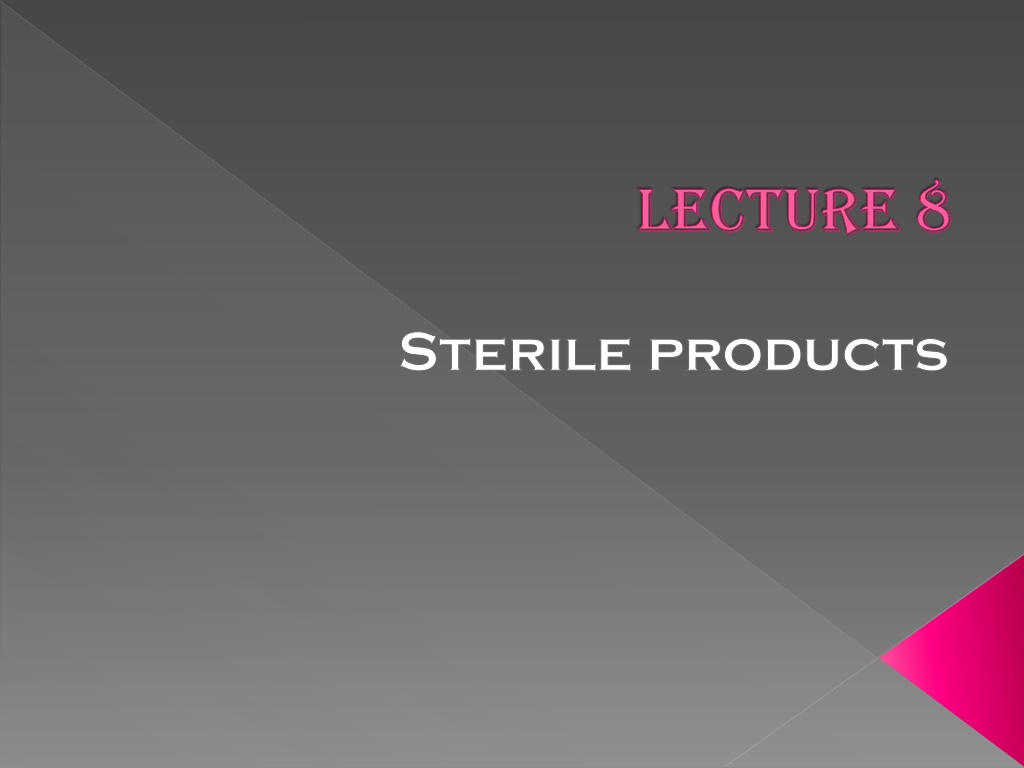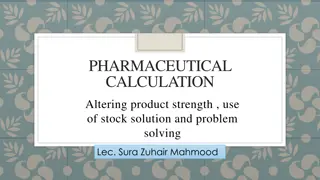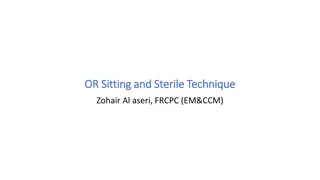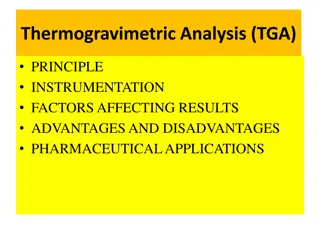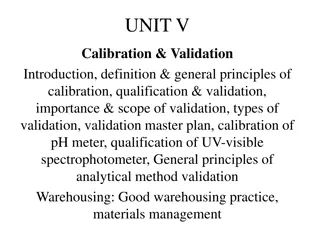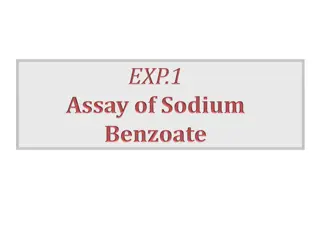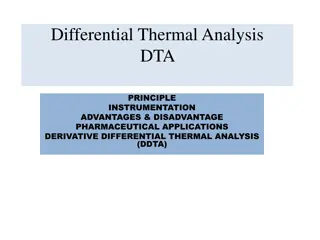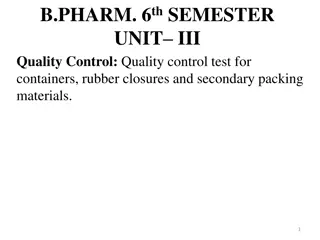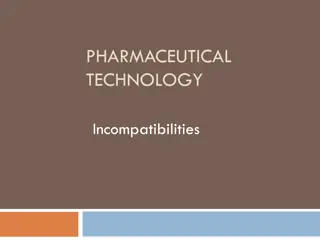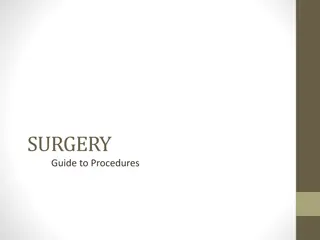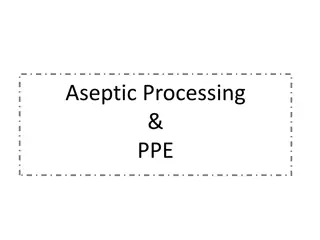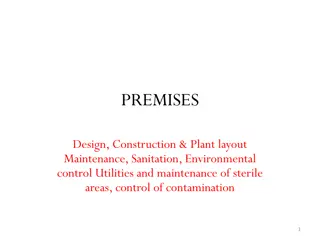Understanding Sterile Pharmaceutical Products Development
Sterile products are dosage forms free of viable microorganisms, crucial for parenteral administrations to ensure therapeutic efficacy and patient safety. This article covers the importance of sterile products in the pharmaceutical industry, the development objectives, different routes of administration, suitable solvents, evaluation of non-aqueous solvents, and requirements for solutes purity. By focusing on sterility and purity, pharmaceutical companies can produce high-quality products for patient care.
Download Presentation

Please find below an Image/Link to download the presentation.
The content on the website is provided AS IS for your information and personal use only. It may not be sold, licensed, or shared on other websites without obtaining consent from the author. Download presentation by click this link. If you encounter any issues during the download, it is possible that the publisher has removed the file from their server.
E N D
Presentation Transcript
Lecture 8 Sterile products
Sterile products Are dosage forms of therapeutic agents that are free of viable M.O. as possess high level of purity including: (Parenteral, ophthalmic, solutions). and irrigating Sterile products used in pharmaceutical industry for product production, control and packaging. development,
Product development Objective: increase of a therapeutic effect in a patient. Parenteral preparations: Like I.V., Intra-spinal, I.M., S.C., intradermal. I.V. and intra-spinal route: given in the form of aq. solution. rather than suspension (to avoid blockage due to P.S., but it should be sterile since (the danger come from sensitivity of nerve tissues and blood capillaries for any contamination).
I.M., S.C., or intradermally: Given in the form of solution, suspension or emulsion but care must be taken to avoid undue tissue irritation and mild local irritation. Notes: 1. Solvent systems suitable for sterile products limited for the products with little or no tissue irritation like water. 2. Physical and chemical contaminants cause irritation to body quantities of these may cause degradation of the products particularly during heating period when thermal sterilization is employed. tissues, since small (chemical changes)
Vehicles (solvents): Most important vehicle for sterile products is water (vehicle for all natural body fluids). (sterilization can be done by distillation or reverse osmosis) To remove dissociated and undissociated organic and inorganic substances present in water (like ionic content and pyrogens) Tests for purity of water: 1- Gravimetric contents of dissociated and undissociated organic and inorganic substances). 2- Electrolyte measurement (conductivity indicate presence of microbes). method (measure total solid for conductivity
Non-aqueous solvents Used in sterile pharmaceutical products because of hydrolytic reactions and solubility factors. Properties of non-aq. solvents: non-toxic, non- irritating, non-sensitizing and no adverse effect on the ingredients of formulations. Evaluation for such solvents (physical properties): density, viscosity, miscibility, polarity, stability, solvent activity and toxicity. Example: solvents miscible with water (PEG 400 & 600, glycerin and propylene glycol) solvents immiscible with water (fixed oils).
Solutes Requirements: Physical and chemical purity (free of microbial and pyrogenic contaminants) determined. Containers for storage of solutes should be designed to prevent contamination especially after open. of solutes should be Added substance (enhance stability of products) (solubilizers, antioxidants, chelating agents, buffers, tonicity contributors, antibacterial agents, antifungal agents, hydrolysis inhibitors and antifoaming agents) Properties: 1- should be non adversely effect on the products. 2- not interfere with therapeutic efficacy nor assay of active ingredients 3- non-toxic
1. Antibacterial agents -(in formulation of multiple dose vial) at Bacteriostatic conc. - In formulations to be sterilized or made by aseptic manipulation. 2. Antioxidants Protect therapeutic agents from oxidation particularly under accelerated conditions of thermal sterilization. They act in many ways: A- Reducing agents B- Blocking agents (oxidative chain reaction) C-Synergist compounds (increase antioxidants). D- Chelating agents (complex with catalysts).
3. Buffers (like Acetate, citrate and phosphate) Maintain required pH since change in pH significant alteration in the rate of degredative reactions Change in pH result from: a) Dissolving glass constituents in the product. b) Release of constituents from rubber closure or plastic components in contact with the product. c) Dissolving of gases and vapors from the airspace in the container and diffusion throughout the plastic or rubber component.
4. Tonicity contributors Compounds that contribute to the isotonicty of a product to reduce pain of injection in areas with nerve endings. (Buffers serve as tonicity contributors as well as stabilizers for the pH). Methods of determination of isotonicty: 1- Freezing point depression 2- Permeability of a living semipermeable membrane into the blood stream.
Containers General notes: 1. Importance appear from direct contact with the products. 2. But no container presently available is totally nonreactive, particularly with aq. solutions. 3. Physical characteristics are the primary consideration in selection of a protective container.
1- Plastic containers Plastic containers for medical field consist of: 1. Thermoplastic polymer 2. Plasticizers 3. Fillers 4. Antioxidants Mainly used because (light in weight, low toxicity, non-breakable, low in additives and low reactivity with the products)
2- Glass containers Glass is a preferred containers for injections. Two glass types available: (soda-lime and borosilicate). Physical characteristics: 1- Protection from UV-light by using amber glass containers (made from iron oxide). 2- Sufficient physical strength to withstand high pressure during autoclaving, shipping, processing and storage. 3- Thermal expansion to withstand thermal shocks during washing and sterilization. 4- Transparency to facilitate inspection. 5- Uniform physical dimensions to facilitate handling by machines in automatic operations.
Rubber closure - Seal openings in vials, bottles - Provide soft and elastic enough to permit entry and withdrawal of a hypodermic needle without loss of integrity of the sealed container. - Non-reactive with the products in contact. Compatibility problems: a) Leaching of ingredients from rubber with subsequent reaction with the product. b) Removal of ingredients from the product by sorption or by vapor transfer through the closure.
Devices Convey of products from container into the body or from one container to another, thus compatibility between product and device is evaluated. Examples: 1. hypodermic needles (stainless-steel) 2. plastic irrigating solution bottles 3. plastic ophthalmic dropping bottles 4. transfer needles 5. transfer set (I.V. catheter from silicone rubber and nylon) All device components must be visible clean and fluid path through the device must meet the same rigid standards for cleanliness as the product.
Formulation (have many examples and here is one example for them): Ophthalmic preparations Instilled into the eye and are similar to parenterals. Characteristics: ingredients as well as freedom from physical (particles), chemicals contaminants. 3- Also free from pyrogen (although not absorbed systemically from eye) but considered microbiologically active. 1-Stable, 2-high purity of and microbial Requirements: antioxidants (stabilizers). Buffers (isotonicty) and
Processing Water for injection Prepared by distillation and Reverse osmosis approved by USP. Specifications for still: 1. Prepurification of water by (deionization or filtration) To improve the quality of distillate and reduce the frequency of required cleaning due to insoluble scale in boiler. 2. Removal of entrained contaminants from vapor before condensed (by passage through an efficient baffle system). 3. Ejection of volatile constituents from top of the system before vapor is cooled To prevent from redissolve and appear in the condensate. 4. Construction of all surfaces that contact with vapor and condensate (from pure tin, 304 stainless steel, or borosilicate glass) To prevent even small traces from dissolve
Reverse osmosis system Functions by applying pressure (200- 400 psi) to raw water sufficient to force permeation of water through a select semipermeable membrane (cellulose ester or polyamides [nylon]in opposite direction from natural osmosis. Retain all macromolecules (pyrogen) and small ions (??+ and ?? ) Greater efficiency and reliability achieved passing through 2 membranes in series.
Rinsing new containers Cleaning treatment, the cycle is essentially rinsing process to loose debris by (hot clean steam and cold treatment and final rinses with filtered WFI), this should be done by using machines for: new glasswares without detergent 1- Containers: inverted in spindles in the front of machine and carried through a series of rinses in one rotation. 2- Ampules and containers with constricted opening makes water drainage incomplete thus a blast of clean air to blow out remaining water. After cleaning containers, are often removed from the rinser and placed in clean stainless boxes for sterilization under the protection of HEPA-filtered airflow.
Cleaning Components Rubber and Plastic Rubber and plastic materials accumulate surface debris accumulated from surface molding operation and from handling (attracted and held electrostatic forces) on surface by Washed by mechanical agitation in a tank of hot detergent solution (0.5% sodium pyrophosphate) followed by a thorough water rinses , the final rinses being WFI.
Filtration of solutions Primary objectives of filtering solutions are Clarification and sterilization Polishing : requires for removal of particulate matter down to at least 3 in size. Further reduction in the size of the particulate matter removed to 0.3 for viable removal of M.O. and spores. Highly desirable characteristic for a sterile solution: solutions having conveys the exceptional quality and purity. high polish impression of
Filling procedures Liquids may be subdivided from a bulk container to individual dose containers more easily and uniformly than a solid. Mechanical subdivision: 1. Mobile, low density liquid achieved by with light-duty machinery. 2. Viscous, sticky or high density liquids requires much more rugged machines to withstand the pressure dispense them. required to
Filling equipment for liquids Filling machines should have parts: 1. Through which liquid flows easily for cleaning and sterilization. 2. Constructed of non-reactive materials such as borosilicate glass or stainless steel. Example: Syringes made from stainless steel when the pressures required for delivery of viscous liquids or large volumes while they are unsafe for glass syringes. Note: Sterile solutions of low potency dispense in large volume (1L) don t require precision of small vol. of potent injectables. So bottles of solutions are filled by gravity, pressure or vacuum filling devices.
Filling equipment for solids Sterile solids (such as antibiotics) aremore difficult to subdivide accurately precisely into individual dose containers than are liquids. The rate of flow of solids tend to be slow and irregular, particularly if finely powdered while small, granular particles flow most evenly. Most containers evenwith large opening must be used; even so, have slow filling rate and a risk of spillage. The tolerance for the content of such containers must be relativelylarge.
Quality Control Sterile products evaluated for: 1. Pyrogen test on WFI 2. Glass tests on containers 3. Identity test on rubber closure 4. Microbial load test to determine No. and type of M.O. present. 5. Conductivity measurement 6. Conformation of volume of fill 7. Leaker test 8. Clarity test 9. Sterility test
Leaker test Intended to detect incompletely sealed ampoules (having capillary pores or tiny cracks) M.O. or dangerous contaminants enter ampoules or contents may leak to the outside and spoil the appearance of package. Detection of leaks by: 1. Spark tester probe (moving from liquid layer into air space). Thus blue spark occur if airspace is evacuated. 2. Dying method (by applying ve pressure and submerged ampoule in 0.5-1% methylene blue dye bath during autoclave cycle adv. Of leaker detection and sterilization) so if dye penetrate then leak is present. Note: capillaries of 15 Micron or smaller may not be detected.
Clarity test Subjective evaluation of the observer. Sterile products should be free from visible particulate ranging from 30 to 40 m and larger in size. Parenteral solutions should be final filter. Visual inspection include (clean container, good light, baffled against reflection into eyes and viewed against black and white background, with contents motion with a swirling action). Note: 1- Moving particles are easy to see than one that is stationary, but care to avoid introducing air bubbles which are difficult to distinguish. 2- Heavy particles invert the container as the final step inspection.
Pyrogen test The presence of pyrogenic substances in parenteral preparations is determined by: In vivo test: a qualitative biologic test based on fever response in rabbits. In vitro test: utilizing gelling property of the LAL. In the presence of pyrogenic endotoxins from gram ve bacteria, a firm gel is formed within 60 min. when incubated at 37 C. Note: A- LAL test is 5-10 times more sensitive than rabbit test. B Greater danger present from injection of large volume solutions containing pyrogens than from small volumes. C- Pyrogenic effect is less with I.M. injection than with I.V.
Packaging Packaging of sterile products to convey for the user the quality, purity and reliability of the product and representing: 1. Dignified 2. Neat 3. Attractiveness 4. Accurate and completely provide with information for its use. 5. Protect the package damage during shipping, handling and storage and from UV radiation (for light sensitive substances). against physical
Packaging according to USP: requirements for injection The volume of an injection for single-dose container should provide the amount specified at one time (to prevent later time use later exposure to contamination). 1. Preparations intended for intraspinal, intracisternal or peridural should be packaged only in single- dose containers (because of sensitivity of nerve tissues to irritation from added substances- such as antibacterial agents- ). 2. No multiple dose container shall contain a volume of injection more than is sufficient to permit withdrawal of 30 ml (because larger volumes would provide for the withdrawal of more doses thereby increasing the potential for contamination). 3.
